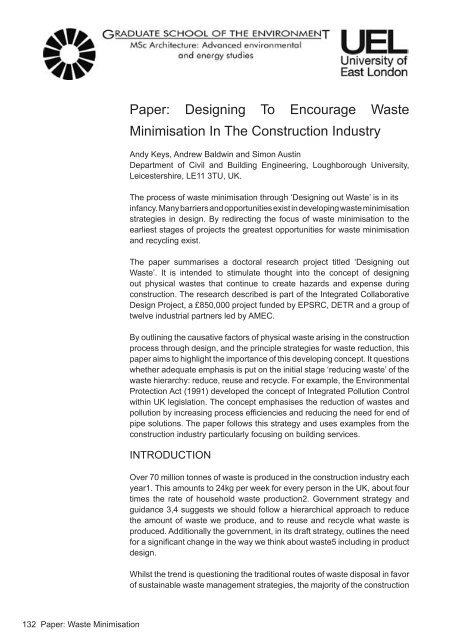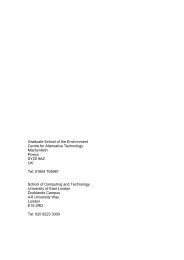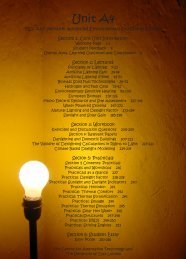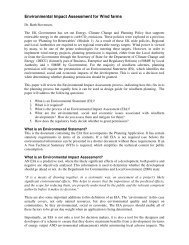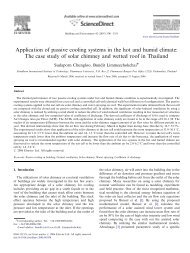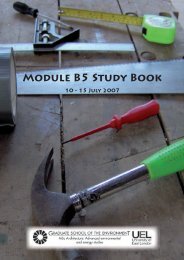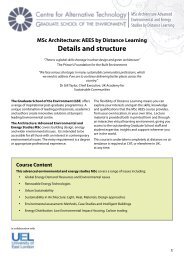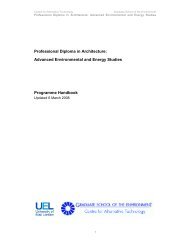Module B1 Study Book - the Graduate School of the Environment
Module B1 Study Book - the Graduate School of the Environment
Module B1 Study Book - the Graduate School of the Environment
Create successful ePaper yourself
Turn your PDF publications into a flip-book with our unique Google optimized e-Paper software.
Paper: Designing To Encourage Waste<br />
Minimisation In The Construction Industry<br />
Andy Keys, Andrew Baldwin and Simon Austin<br />
Department <strong>of</strong> Civil and Building Engineering, Loughborough University,<br />
Leicestershire, LE11 3TU, UK.<br />
The process <strong>of</strong> waste minimisation through ‘Designing out Waste’ is in its<br />
infancy. Many barriers and opportunities exist in developing waste minimisation<br />
strategies in design. By redirecting <strong>the</strong> focus <strong>of</strong> waste minimisation to <strong>the</strong><br />
earliest stages <strong>of</strong> projects <strong>the</strong> greatest opportunities for waste minimisation<br />
and recycling exist.<br />
The paper summarises a doctoral research project titled ‘Designing out<br />
Waste’. It is intended to stimulate thought into <strong>the</strong> concept <strong>of</strong> designing<br />
out physical wastes that continue to create hazards and expense during<br />
construction. The research described is part <strong>of</strong> <strong>the</strong> Integrated Collaborative<br />
Design Project, a £850,000 project funded by EPSRC, DETR and a group <strong>of</strong><br />
twelve industrial partners led by AMEC.<br />
By outlining <strong>the</strong> causative factors <strong>of</strong> physical waste arising in <strong>the</strong> construction<br />
process through design, and <strong>the</strong> principle strategies for waste reduction, this<br />
paper aims to highlight <strong>the</strong> importance <strong>of</strong> this developing concept. It questions<br />
whe<strong>the</strong>r adequate emphasis is put on <strong>the</strong> initial stage ‘reducing waste’ <strong>of</strong> <strong>the</strong><br />
waste hierarchy: reduce, reuse and recycle. For example, <strong>the</strong> <strong>Environment</strong>al<br />
Protection Act (1991) developed <strong>the</strong> concept <strong>of</strong> Integrated Pollution Control<br />
within UK legislation. The concept emphasises <strong>the</strong> reduction <strong>of</strong> wastes and<br />
pollution by increasing process efficiencies and reducing <strong>the</strong> need for end <strong>of</strong><br />
pipe solutions. The paper follows this strategy and uses examples from <strong>the</strong><br />
construction industry particularly focusing on building services.<br />
INTRODUCTION<br />
Over 70 million tonnes <strong>of</strong> waste is produced in <strong>the</strong> construction industry each<br />
year1. This amounts to 24kg per week for every person in <strong>the</strong> UK, about four<br />
times <strong>the</strong> rate <strong>of</strong> household waste production2. Government strategy and<br />
guidance 3,4 suggests we should follow a hierarchical approach to reduce<br />
<strong>the</strong> amount <strong>of</strong> waste we produce, and to reuse and recycle what waste is<br />
produced. Additionally <strong>the</strong> government, in its draft strategy, outlines <strong>the</strong> need<br />
for a significant change in <strong>the</strong> way we think about waste5 including in product<br />
design.<br />
Whilst <strong>the</strong> trend is questioning <strong>the</strong> traditional routes <strong>of</strong> waste disposal in favor<br />
<strong>of</strong> sustainable waste management strategies, <strong>the</strong> majority <strong>of</strong> <strong>the</strong> construction<br />
132 Paper: Waste Minimisation


